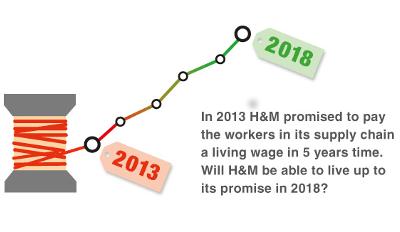
Shortly after achieving great fanfare for their remarkable living wage promise, H&M set out to reformulate this promise towards a less ambitious course. Instead of paying all the workers in its supply chain a living wage directly, H&M clarified they would only put ‘mechanisms’ in place which would enable payment of living wages to at least 80% of the workers its supply chain. The actual practical and measurable steps to achieve this goal have not been shared publicly nor has H&M been transparent about their wage pilot projects. This precludes workers and labour organizations from tracking progress of H&M’s living wage promise.
The goal that H&M set itself in 2013, to pay a living wage to 850,000 garment workers in their supply chain, while ambitious, is certainly possible and affordable for a company with the size, profit, and power as H&M. For example, the company’s chairman himself, Stefan Persson, could easily provide the H&M workers with a top up on their wages until the moment that H&M has sorted out the payment of a living wage. He is currently worth 19.9 billion dollars, which would be enough to pay all H&M garment workers in Bangladesh a full living wage for the next thirty years.
Ineke Zeldenrust states: "H&M certainly has the financial means to ‘walk the talk’, and has stated time and again they want to be a leader on these issues. We have looked at the numbers and if H&M were to reallocate just one year of its annual advertising budget towards wages, they could pay their Cambodian workers a living wage for 6.5 years."
H&M’s net profit in 2016 was over 2 billion USD (18,636 million SEK). It would cost H&M only 1.9% of this profit to pay all its workers in Cambodia the additional 78 USD every month they would need to meet a living wage standard.
